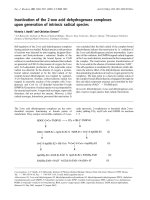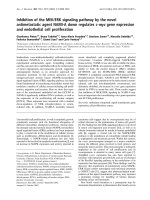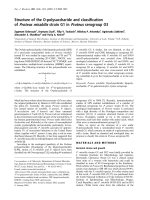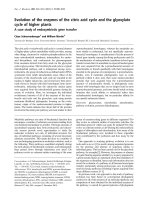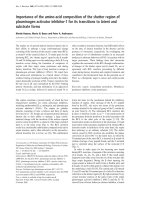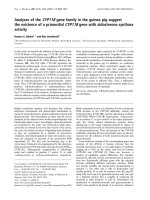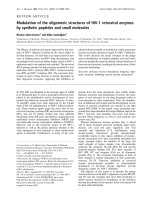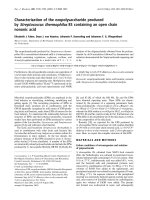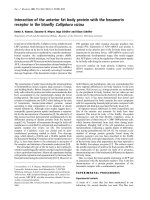Báo cáo y học: "Relevance of the stroma and epithelial-mesenchymal transition (EMT) for the rheumatic diseases" docx
Bạn đang xem bản rút gọn của tài liệu. Xem và tải ngay bản đầy đủ của tài liệu tại đây (1.17 MB, 11 trang )
Page 1 of 11
(page number not for citation purposes)
Available online />Abstract
Epithelial-mesenchymal transition (EMT) is a term applied to the
process whereby cells undergo a switch from an epithelial
phenotype with tight junctions, lateral, apical, and basal
membranes, and lack of mobility into mesenchymal cells that have
loose interactions with other cells, are non-polarized, motile and
produce an extracellular matrix. The importance of this process
was initially recognized from a very early step in embryology, but
more recently as a potential mechanism for the progression and
spread of epithelial cancers. As the sequence of morphological
changes has become understood in molecular terms, diseases
characterized by alterations in stromal elements and fibrosis are
being considered as examples of EMT. This review will focus on
the pathogenetic features of immune-mediated renal disease,
systemic sclerosis and rheumatoid arthritis that could be explained
by EMT.
The relevance of the stroma and epithelial-
mesenchymal transition for rheumatic
diseases
Epithelial-mesenchymal transition (EMT) describes a process
wherein static epithelial cells lose cell-cell contacts, acquire
mesenchymal features and manifest a migratory phenotype.
Multiple alternative terms, including epithelial-mesenchymal
interactions, transformation, transdifferentation, and transition,
have been used interchangeably to describe this process. I’ve
chosen ‘transition’ for the reasons elaborated by Kalluri and
Neilson [1], whose excellent publication is recommended to
any reader interested in the entire subject. EMT, which was first
appreciated by developmental biologists in the 1980s, is now
attracting the attention of investigators interested in metastatic
cancers and diseases characterized by fibrosis [1,2]. This
review will explain these observations briefly and consider how
they might be relevant to certain rheumatic diseases.
In the embryo the first and only tissue formed is epithelium
[3]. Sheets of epithelial cells are held together tightly at
strong adherens junctions containing E-cadherin in
complexes with catenins linked to the actin cytoskeleton. The
epithelial cells are firmly attached through integrins to an
underlying extracellular matrix (ECM) containing type IV
collagen and laminin; the basement membrane. Around day
15 the epiblast cells of the developing human embryo migrate
into a structure called the primitive streak [4]. Once in place
they assume the features of embryonic mesoderm and
endoderm in a process known as gastrulation. From the
mesoderm arise the visceral and limb bud mesenchyme. The
latter is the source of bone, cartilage, fibroblasts, fat, skeletal
muscle and the bone marrow stroma.
Although mesenchymal cells are secretory and produce
collagens, fibronectin, vimentin, and alpha smooth muscle
actin (αSMA), no one of these is unique to this cell type. The
attribute that sets mesenchymal cells apart is their ability to
invade and move through the three-dimensional structure of
the ECM. Accordingly, mesenchymal cells are defined by
morphology and behavior: front end to back end polarity;
elongated morphology; filopodia; and invasive motility [3].
Signaling pathways used in development
The wnt and transforming growth factor (TGF)-β signaling
families are essential for development of the primitive streak
and the induction of EMT [5,6]. Each acts through the
transcription factor LEF-1/TCF, a member of the family of
HMG-box DNA binding proteins, which has binding sites for
both Smads and catenin signaling molecules [7]. The primacy
of LEF-1/TCF can be demonstrated by transfecting epithelial
cells with LEF-1/TCF DNA and observing that they lose their
epithelial features and acquire a motile mesencyhmal
Review
Relevance of the stroma and epithelial-mesenchymal transition
(EMT) for the rheumatic diseases
Nathan J Zvaifler
School of Medicine, University of California, San Diego, La Jolla, CA 92093-0656, USA
Corresponding author: Nathan J Zvaifler,
Published: 9 May 2006 Arthritis Research & Therapy 2006, 8:210 (doi:10.1186/ar1963)
This article is online at />© 2006 BioMed Central Ltd
αSMA = alpha smooth muscle actin; BMP = bone morphogenic protein; CAF = cancer associated fibroblast; ECM = extracellular matrix; EMT =
epithelial-mesenchymal transition; FLS = fibroblast-like synoviocyte; FSP-1 = fibroblast specific protein 1; MMP = matrix metalloproteinase; MPC =
mesenchymal progenitor cell; MSC = mesenchymal stem cell; RA = rheumatoid arthritis; RTE = renal tubular epithelium; SDF = stromal derived
factor; SSc = systemic sclerosis; TGF = transforming growth factor; TNF = tumor necrosis factor.
Page 2 of 11
(page number not for citation purposes)
Arthritis Research & Therapy Vol 8 No 3 Zvaifler
phenotype. Conversely, mesenchymal cell lines become
epithelial when transformed by E-cadherin genes [6].
The wnt signaling pathway regulates the amounts of
β-catenin protein available within the cell for binding to the
cytoplasmic tail domain of cadherins, which mediates cell-cell
adhesion, and to cytoskeletal (F actin) elements [8]. In the
resting state, β-catenin is in the cytoplasm associated with
adenomatous polyposis coli protein and axin, which results in
its ubiquination and subsequent degradation by the
proteosome (Figure 1). Normally, a balance is maintained
between a relatively stable pool of β-catenin associated with
adherens junctions and a small, rapidly degraded cytosolic
pool [9]. Engagement of wnt glycoprotein by cell surface
frizzled receptors results in an excess of free cytosolic, non-
phosphorylated β-catenin, which can enter the nucleus and
engage LEF-1/TCF DNA binding proteins, transforming them
into transcriptional activators of the genes central to EMT,
including the down-regulation of E-cadherin genes.
Binding of TGF-β ligands to their tetrameric type I and II
receptors causes sequential activation of MKK-4/JNK and the
complex of Smad 2/3 and Smad 4 proteins (Figure 2). This
complex can enter the nucleus and engage LEF-1/TCF at a
site separate from the β-catenin binding site [7], but with
similar results; namely, induction of EMT genes, E-cadherin
down-regulation, and acquisition of mesenchymal features
[10,11].
In addition to LEF-1/TCF, a family of transcription factors that
can cause EMT and down-regulate E-cadherin expression
has recently been identified (Figure 3). These repressors,
bearing fanciful names like Snail, Slug, Sip-1, and Twist, exert
their effects by binding to different E-boxes in the E-cadherin
promoter [12]. Wnt and TGF-β can also up-regulate these
E-cadherin repressors.
EMT and malignancies of epithelial cells
(carcinomas)
Often genes important in embryogenesis have an oncogenic
potential (i.e., the ability to initiate tumors), but the
Figure 1
Wnt/β-catenin signaling pathway. In resting cells, glycogen synthase
kinase 3 (GSK3β) is in a complex with CK1, β-catenin, axin and
adenomatous polyposis coli protein. In this state, β-catenin is primed
for phosphorylation by GSK3β. The phosphorylated β-catenin is
degraded by ubiquitination. In the activated state (upon Wnt binding to
Fz), Wnt-Fz and LDL receptor-related protein 5/6 (LRP) coordinate Dvl
(disheveled, an adaptor protein) activation, which results in recruitment
of axin to the plasma membrane. This leads to dissociation and
inactivation of GSK3β, which can no longer phosphorylate β-catenin.
Free β-catenin translocates to the nucleus and induces gene
expression in a complex with LEF-1/T cell factor (TCF) family
transcription factors, down regulating E-cadherin genes and initiating
epithelial mesenchymal transition. (Adapted from [8].)
Figure 2
The canonical transforming growth factor (TGF)-β/Smad signaling
pathway. Members of the TGF-β family of growth factors (TGF-βs,
activins, nodals) interact sequentially with two membrane receptors.
TGF binds first to the constitutively active type II receptor (R) and then
the ligand-recepor complex associates with type I TGF-R. TGF-IIR
(TβIIR) phosphorylates TGF-IR (TβIR) on a cluster of serine threonine
residues. Activated TGF-RI propogates the signal downstream by
directly phosphorylating Smad2 and Smad3. These form heterodimeric
or trimeric complexes with Smad 4 and translocate into the nucleus
where, in combination with LEF-1/T cell factor (TCF) family
transcription factors, they down-regulate E-cadherin genes and initiate
epithelial-mesenchymal transition. Complexes of Smad7 and Smurf1 or
Smurf2 promote ubiquination and degradation of activated receptors
limiting the intensity and duration of signaling. P, phosphorylation sites;
SARA, small anchor for receptor activity. (Adapted from [61].)
Page 3 of 11
(page number not for citation purposes)
propagation and spread of these tumors depends on several
different processes [13]. Many separate steps are involved in
metastasis of neoplastic epithelial cells, namely expansion
into local tissues, penetration of blood and lymphatic vessels,
entrance into the systemic circulation (intravasation), subse-
quent extravasation through the vascular endothelium at
distant locations, and the establishment of new tumors. Each
of these steps has been analyzed by gene-expression
microarrays in both experimental animals and man [14-17].
The conversion from a sessile tumor to an invasive carcinoma
results from the loss of constraints imposed by cell-cell
adhesion, that is, EMT. The level of E-cadherin expression is
often inversely correlated with tumor grade and stage and
inactivating mutations of E-cadherin are present in 50% of
lobular breast carcinomas [18,19].
Equally important are E-cadherin repressors. In a very
influential paper, Yang and colleagues [20] found elevated
levels of Twist expression in mouse mammary gland tumors at
every stage of metastasis. Reduction of the expression level
of Twist substantially reduced tumor cell intravasation, but
had no effect on the histology or growth rate of the primary
tumor. Kang and Massague [21] recently reviewed the
contribution of additional pathways and E-cadherin repressors
to metastatic disease (Figure 3). They also pointed out that
the number of carcinoma cells that have undergone EMT and
appear as stromal elements is likely to be underestimated.
This is an important consideration given the interest in the
influence of the stromal environment on neoplasia.
The role of the ECM and stroma in cancer
Stroma is the tissue that forms the ground substance,
framework or matrix of an organ. New studies suggest that
the cancer cell microenvironment not only facilitates tumor
progression, but also may occasionally initiate the oncogenic
conversion of epithelial cells [22,23]. An example of the
former is the study of Orimo and colleagues [24], who
isolated cancer associated fibroblasts (CAFs) from six human
breast cancers and compared them to fibroblasts isolated
from a nearby non-cancerous region of the same breast
(counterpart fibroblasts). CAFs were more competent in
supporting in vivo growth of tumor cells and enhanced tumor
angiogenesis and the recruitment and mobilization of
endothelial progenitor cells. Cancer associated fibroblasts
express traits of activated fibroblasts (myofibroblasts with
increased αSMA staining) when compared to counterpart
fibroblasts or normal fibroblasts. CAFs expressed high levels
of stromal derived factor (SDF)-1, which is responsible for the
chemotaxis of endothelial progenitor cells and contributes to
angiogenesis and tumor growth by acting in a paracrine
manner on the CXCR4 receptors of tumor cells. A compre-
hensive gene expression profile of breast carcinomas noted
significant overexpression of the chemokines CXCL14 and
CXCL12 in tumor myoepithelial cells and myofibroblasts [25].
These authors proposed that locally produced chemokines
bind to receptors on epithelial cells, enhancing their
proliferation, migration, and invasion.
Rat mammary adenocarcinomas develop when just the
stroma is treated with a carcinogen (N-nitrosomethyl-urea)
regardless of the exposure of epithelial cells [26]. In a related
study, TGFβ-1 and the extracellular matrix protein laminin-5
induced EMT and hepatocellular carcinoma cell invasion by
upregulating Snail and Slug, down regulating E-cadherin,
translocating β-catenin into nuclei, and inducing dramatic
spreading and morphological changes in the cancer cells
[27]. Similar changes were not observed with the peritumoral
tissues from the same hepatocellular carcinoma patients.
EMT was blocked by antibody to alpha 3, but not alpha 6
integrins, supporting the critical role of laminin 5 in these
processes [27]. In a related study, tissue derived fibroblasts
modulated the integrin-dependent interactions (alpha-5,
alpha-6, beta 1) between the gastric cell line HGT-1 and
fibronectin [28]. Hepatocyte growth factor produced by
autologous stromal fibroblasts augments the growth of
human small cell lung cancer in nude mice [29]. Exposure to
CAFs transformed non-tumorogenic prostate epithelial cells
into neoplasms [30,31] and fibroblasts from tumor stroma
Available online />Figure 3
Drivers and mediators of epithelial-mesenchymal transition (EMT). Early
stage tumor cells maintain epithelial properties similar to the neighboring
normal epithelium. The accidental overexpression of master regulators of
EMT, such as the transcription factors Twist, Snail, and SIP1, in cancer
cells leads to dramatic changes in gene expression profiles and cellular
behavior. Twist, Snail, and SIP1 repress the expression of E-cadherin via
E boxes in its promoter and trigger expression of an entire EMT
transcriptional program through as yet unknown mechanisms. Several
pathways are known to regulate Twist, Snail, and SIP1 expression in
tumor cells while others (shown in parentheses) do so at least in
developmental contexts. (Adapted from [21].)
induced malignant transformation with dysregulation of
several chromosones in the non-tumorogenic SV40 immorta-
lized, prostate line BPH-1 [32].
Conversely, in some experimental models, the stroma can
normalize carcinomatous epithelial cells. For instance,
mammary gland stroma from mature and multiparous rats
interferes with the development of neoplastic breast tissue
and encourages normal ductal growth of grafted epithelial
cancer cells, whereas 6 months after inoculation tumors
developed in 75%, 100% and 50% of 24-, 52-, and 80-day
old virgin rats [33]. These observations, although un-
explained, have obvious clinical implications.
Fibrotic disorders
Kidney disease
Wound healing results from a sequential process of
inflammation, leukocyte infiltration, cytokine and growth factor
release, and formation of a scaffold composed of collagens
and other matrix molecules into which fibroblasts enter and
proliferate. Healing and fibrotic scaring are advantageous in
wounds, but they can be pathological in the kidneys, the
lungs and the liver [1]. Extensive investigations in mice, rats,
and man of acute and chronic renal fibrinogenesis implicate
EMT as the cause for cells of the renal tubular epithelium
(RTE) becoming interstitial fibroblasts [34,35].
For instance, in vitro exposure of isolated RTE to graded
doses of cyclosporine A results in cellular elongation, detach-
ment and cytoskeletal reorganization. αSMA expression
occurred in the treated cells with a concomitant dose-
dependent production of TGF-β [36].
A model of unilateral hydronephrosis provides a comparison
of events in the obstructed and normal kidneys [37]. Unlike
the lung, the kidney interstitium normally has few fibroblasts.
Ureteral obstruction causes rapid (within days) interstitial
fibrosis, while the control kidney remains normal. The
sequence of events was traced with an antibody to a
‘fibroblast specific protein 1’ (FSP-1), which disclosed
staining of RTE trapped in damaged nephrons [38]. The
FSP-1 positive epithelial cells traversed the damaged tubular
basement membrane and increasing numbers of FSP-1
positive fibroblasts appeared in the interstitium. The cells had
lost their epithelial markers and gained a fibroblast phenotype
[38]. Unfortunately, anti-FSP-1 staining is not exclusive for
fibroblasts [39]. The cascade of EMT, interstitial infiltration,
and eventual renal fibrosis resulting from an interplay of
hypoxia, inflammatory mediators, growth factors and matrix
metalloproteinases (MMPs) produced by invading inflam-
matory cells, resident fibroblasts and RTE is illustrated in
Figure 4 [40]. But TGF-β is central to the fibrotic process and
strategies that reduce TGF-β levels restore the loss of
E-cadherin and inhibit EMT. In cell culture systems, bone
morphogenic protein (BMP)-7, an intracellular competitor of
TGF-β signaling, reverses interstitial fibrosis and impaired
renal function in several murine models of kidney failure,
including lupus nephritis [34,41-43].
The myofibroblast was initially described as a reversibly
activated fibroblast found in healing wounds that exhibits
contractility needed for scar retraction and strong expression
of αSMA. Subsequently, this same myofilament protein
(αSMA) was demonstrated in most fibrotic processes in
multiple tissues from various species [44,45]. Faulkner and
colleagues [46] questioned if prior renal injury accelerates
the progression of glomerulo-sclerosis and interstitial fibrosis
caused by sustained renal vascular injury. Glomerular injury
was induced in rats by Habu venom; immediately thereafter
they were exposed to continuous infusions of angiotensin II.
End-stage renal disease and severe fibrosis developed in 14
days and the combination treatment was more damaging than
either one alone. Within 24 to 48 hours, αSMA(+) myofibro-
blasts appeared in the peritubular interstitial spaces, while
αSMA(–), Na+,K+-ATPase(+), Texas red-dextran labeled
RTE was excluded. Over the next two weeks the tubular cell
loss was seen to result from encroachment by interstitial
myofibroblasts; not by EMT [46].
The origins of myofibroblasts have not been established, but
it’s unlikely that they originate from a single source. An earlier
study with bone marrow chimeras and transgenic reporter
mice showed that 36% of the new fibroblasts responsible for
renal fibrogenesis came from local EMT, 14% to 15% came
from the bone marrow and the rest from local proliferation [1].
Thus, a failure to identify a ‘final common pathway’ probably
reflects differences in the kinds of insults used to create the
individual renal injury.
Fibroblasts, fibrosis and systemic sclerosis
Until recently, scleroderma research focused mainly on the
unique nature of the systemic sclerosis (SSc) fibroblast, its
ability to produce ECM molecules, especially collagens, and
the responsible growth factors, especially TGF-β [47-49].
Lately, the emphasis has shifted, prompted by recognition of
the heterogeneity in the origins and phenotype of fibroblasts
[50]. But, as with renal fibrosis, opinions about the SSc
fibroblast vary. Postlewaite and colleagues [51], in an
admirable review, elaborated the prevailing theories and,
based on studies from their own laboratory, suggested that
conventional, circulating CD14(+) monocytes transdifferen-
tiate into SSc fibroblasts. Another cell, the fibrocyte, initially
described in the context of wound repair, can participate in
granuloma formation, antigen presentation and is a source of
contractile myofibroblasts found in a variety of fibrosing
lesions [52] (discussed below). British workers favor a link
between vascular damage (an essential requirement in any
scheme of SSc pathogenesis) and the formation of myofibro-
blasts from pericytes [53]. The latter are derived primarily
from mesenchymal cell precursors. Under the influence of
various growth factors they become either endothelial cells
(vascular endothelial growth factor) or pericyte/smooth muscle
Arthritis Research & Therapy Vol 8 No 3 Zvaifler
Page 4 of 11
(page number not for citation purposes)
cells (platelet-derived growth factor-BB) [54]. A monoclonal
antibody, STRO-1, identifies a subpopulation of bone marrow
stromal cells that give rise to fibroblasts (colony forming units
[CFUs]) [55]. Yet the same antibody applied to rheumatoid
arthritis (RA) synovium only stains periadventitial vascular
cells (pericytes) (Figure 5). Pericytes provide structure to blood
vessel walls, synthesize basement membrane proteins, and
regulate blood flow and vascular permeability. In their
capacity as primitive mesenchymal cells, pericytes can be a
source of several tissues, including cartilage and bone
[56,57]. Thus, both tissue fibrosis and ectopic calcification
(features of SSc) could be attributed to pericytes.
Human myofibroblasts reside in a fraction of fibroblasts that
react with Thy-1 antibody [58]. Myofibroblasts are the hallmark
of idiopathic pulmonary fibrosis [58,59]. Rat alveolar epithelial
cells exposed in vitro to TGF-β for 6 days develop a fibroblast
morphology and molecular markers associated with EMT. This
effect is enhanced by tumor necrosis factor (TNF)-α [59].
Cells co-expressing epithelial markers and αSMA are
abundant in lung tissues from idiopathic pulmonary fibrosis
patients. Mice with a targeted deletion of Smad3, a critical
molecule in the TGF-β signaling pathway, fail to develop EMT
and tissue fibrosis in experimental models of pulmonary, renal,
liver, ocular and radiation induced skin injury [60].
Overexpression of the inhibitory Smad7 protein or treatment
with a small molecule inhibitor of Smad 3 reduces the fibrotic
response in all of these animal models (including murine
systemic lupus erythematosus) and holds out a promise for
treatment of pathological fibrotic human diseases [60,61].
EMT cannot explain all fibrotic conditions, however. Bleo-
mycin treatment is complicated by pulmonary fibrosis, akin to
SSc. Repeated local injections of bleomycin induces a
murine model of scleroderma [62]. Yet in vitro studies of
alveolar epithelial cell lines and immunohistochemical analysis
of pulmonary fibrosis from bleomycin-treated mice and rats
show no features of EMT [63].
Rheumatoid arthritis as a disease of stroma?
The tissue invasion and destruction of cartilage and bone by
stromal elements (known as pannus) as seen in RA joints is
often compared to cancer. HG Fassbender, a student of RA
Available online />Page 5 of 11
(page number not for citation purposes)
Figure 4
Schematic illustration of the key events of epithelial-mesenchymal transition (EMT) involving the renal tubular basement membrane (TBM) and
possible therapeutic interventions. The diagram illustrates four key events essential for the completion of EMT: loss of epithelial adhesion
properties; de novo alpha smooth muscle actin (αSMA) expression and actin reorganization; disruption of TBM; and enhanced cell migration and
invasion capacity. Transforming growth factor (TGF)-1 alone is capable of inducing tubular epithelial cells to undergo all four steps. Strategies to
block any steps during EMT would have a major impact on EMT and, thereby, on renal fibrosis. For instance, hepatocyte growth factor (HGF) and
bone morphogenic protein (BMP)-7 could antagonize TGF-1 and consequently inhibit the initiation of EMT (step 1). Blockade of angiotensin (Ang)II
by losartan abolishes its activity as an EMT promoter and attenuates renal fibrosis (step 2). Preservation of TBM integrity in tPA–/– mice selectively
blocked EMT in obstructive nephropathy (step 3). Finally, pharmacological inhibition of ROCK kinase impairs cell migration and reduces renal
fibrosis (step 4). MMP, matrix metalloproteinase. (Adapted from [35].)
pathology, remarked on the changes in the synovial stroma:
“Normally this consists of loosely arranged collagen fibers
with a small number of spindle shaped fibrocytes. In
association with exudation of fibrin the local connective tissue
cells proliferate. These cells may resemble the cells of the
surface layer to such an extent that recognition of separate
layers becomes impossible. In particularly gross examples,
these large cells may lie so close together that any interstitial
substance becomes unrecognizable” — he called this
appearance “mesenchymoid transformation” (figures 124 to
126 in [64]). More recent research on RA pathogenesis has
concentrated on the immuno-hematological and angiogenic
elements found in the synovium. Mast cells, important in
modifying ECM by elaborating proteases and tryptic
enzymes, are reviewed elsewhere [65]. Only in the past 10 to
15 years has the import of synovial fibroblasts, lining cells and
other mesenchymal elements been reconsidered [66-69].
How might such cells contribute to the pathogenesis of joint
inflammation and bone and cartilage destruction? First, by
their sheer bulk and metabolic needs. Most standard texts
report that the number of intimal cells (fibroblast like
synoviocytes (FLSs)) increase with inflammation from a few
cells to 8 to 10 lining cells. But this is only what can be seen
in thin (5 to 6 micron) histological sections. In reality,
however, even in a large joint like the knee, the normal
synovial membrane is a thin, filmy structure weighing just a
few milligrams, whereas the inflamed, redundant synovium
that is removed at surgery can weigh kilograms, a million-fold
increase over normal. Much of the increased weight results
from tissue edema, hypervascularity and the ingress of
numerous blood cells, but tissue fibroblasts and FLSs also
make a significant contribution
Second, fibroblasts are not inert cells. They both make and
degrade matrix elements, especially collagen and fibronectin,
into numerous bioactive peptides. Fibroblasts operate through
both cytokine independent and dependent pathways; they
recruit and stimulate T cells and monocytes by the production
of chemokines, especially IL-6 and SDF-1 (CXCL12) and they
can attract and retain B lymphocytes by B cell activation factor
of the TNF family (Blys) production. Fibroblasts are antigen
presenting cells and elaborate numerous pro-inflammatory
cytokines, including TNF-α and IL-1 (detailed in [68]).
What accounts for the massive increase in fibroblasts?
Knowledge of their origins, or the origin of any RA stromal
element, is incomplete. Local proliferation of resident
fibroblasts responding to the inflammatory milieu of the RA
synovium is certainly a possibility [66]. This explanation was
initially invoked, then rejected, and later reconsidered, but
proliferation alone cannot account for all of the increase.
Subsequently, a prolonged life span of FLSs was recognized
(reviewed in [68,69]), although even a combination of
enhanced proliferation of the normally slow growing FLSs
plus defective apoptosis seems an insufficient explanation.
What about EMT? Several factors that can modulate
fibroblast formation are found in the RA synovium, either as
genes or proteins; for example, large amounts of both latent
and activated TGF-β I and II are present in RA synovium and
synovial fluids [70-72]. Rheumatoid articular tissues have
mesenchymal appearing cells that stain with an antibody to
phosphorylated Smad 2/3, suggesting engagement of TGF-β
receptors and activation of ECM through the TGF-β signaling
pathway [73] (Figure 2). Myofibroblasts and/or cells that
react with an antibody to αSMA are absent from normal or
Arthritis Research & Therapy Vol 8 No 3 Zvaifler
Page 6 of 11
(page number not for citation purposes)
Figure 5
Microscopic sections of synovial tissue from a patient with rheumatoid arthritis stained with the STRO-1 antibody. In the bone marrow STRO-1
reacts with stromal elements that are progenitors of fibroblasts (CFU-F) [55], but staining in the synovium is limited to perivascular mesenchymal
cells (pericytes). JS, joint space.
osteoarthritis synovium, but are detected in a proportion of
synovial fibroblasts [74,75]. Common constituents of the
ECM, such as MMPs and hyaluronan, can stimulate fibroblast
formation through EMT. For example, ectopic expression of
MMP3 (also known as stromelysin-1) in normal epithelial cells
induces a fibroblast-like phenotype by mediating trans-
criptional upregulation of Rac-1b and enhanced production
of reactive oxygen species. This results in genomic instability
and increased expression of the Snail transcription factor.
Snail down modulates E-cadherin and initiates the EMT
cascade [76] (Figure 3). Hyaluronan (a major glycosamino-
glycan of the ECM) is critical for EMT in the embryo [3]. It can
induce a fibroblast morphology, anchorage independent
growth, loss of adhesion molecules at cell junctions, up-
regulate vimentin expression in epithelial cells and supports
tumor growth and invasion in vivo [77,78]. However, there
are some important reservations about the role of EMT in the
synovium because: very few cells have epithelial features;
classical E-cadherins are scant; and the synovial lining lacks a
basement membrane [79]. Normal FLSs probably stick
together through homotypic adhesion mediated by a newly
described molecule, cadherin 11 [80], whose regulation and
role in the RA synovium is currently under investigation [81].
Since neither increased proliferation, inadequate apoptosis,
nor EMT is responsible for the accumulation of fibroblasts in
the joint, how do we explain abnormalities, quantitative or
qualitative, of the articular stroma? The ingress of mesen-
chymal elements or their progenitors must be considered.
There is certainly a precedent, because most inflammatory,
immunological, and angiogenic cells in the synovium come
from the blood. Are there such mesenchymal cells? One
candidate is the fibrocyte, a marrow derived cell of hemato-
poetic lineage, thus CD34+, that circulates in the blood and
responds to inflammatory cues [52]. Fibrocytes participate in
wound healing [82], are thought to be responsible for the
thick, hard skin seen in some dialysis patients with renal
insufficiency (nephrogenic fibrosing dermopathy) [83], and
could have a role in other fibrotic disorders [51]. However,
fibrocytes have not been reported in synovial tissues and their
numbers in the blood of RA patients are not different from
normal individuals (NJZ, personal observation).
A second candidate, a mesenchymal stem cell (MSC) or
mesenchymal progenitor cell (MPC), resides in the bone
marrow [84], circulates in the blood [85], and has been found
in a variety of normal tissues, including periarticular marrow,
periosteum and synovium [86-89]. MSCs/MPCs are CD34(–)
and lack a single, defining antigen, but can be phenotyped by
a combination of cell surface markers, including thy-1
(CD90), endoglin (CD105), ALCAM (CD166) [84], and
receptors for low affinity nerve growth factor (LNGFR1) and
BMP (BMPR1A and II) [89]. Cells with these features are
present in joints. Marinova and colleagues [90] recognized a
small population of large, adherent, stromal-appearing cells in
primary cultures of inflammatory joint effusions. These stained
with antibodies to mesenchymal elements (collagen I,
vimentin, αSMA and BMP receptors), and maintained this
phenotype through multiple passages in tissue culture [89].
An anti-BMPR II antibody reacted with 11.6% of the FLSs
from RA synovial fluids (passages 3 to 6), but only 2% from
non-inflammatory osteoarthritis fluids. BMPR IA and II
expressing cells were identified in RA synovial tissues —
approximately 25% of intimal lining cells and 7% in the
sublining tissues. Strong staining was seen at the advancing
front of pannus and sites of bone erosions [90].
Jones and colleagues [91] used a fibroblast CFU assay to
quantify MPCs in synovial effusions from various kinds of
arthritis (53 RA, 20 osteoarthritis, 27 miscellaneous). Unlike
the earlier study [90], the numbers of MSCs per ml of
synovial fluid was higher in osteoarthritis than in RA effusions.
Fibroblasts from synovial fluids had trilineage potential and
under appropriate conditions could be induced to become
either fat, cartilage, or bone cells. The synovial fluid
fibroblasts stained with standard mesenchymal cell
antibodies. Rare cells expressed the low affinity nerve growth
factor receptor. Whether they are the same as the BMPR(+)
cells remains to be determined. The authors interpreted their
findings as evidence that the MSCs were derived from
“injured joint structures” (i.e., cartilage) [91]. Synovial tissues
were not examined in this study.
Patients with a diagnosis of RA differ from each other in many
ways: clinical features, disease course, response to
treatment, serologies and synovial immunohistology can all be
cited. Of late, cDNA microarray technology has identified
distinctive profiles among articular tissues from RA subjects
and the relationship of particular genes to specific disease
features is being examined [75,92-95]. Given the complex
cellular makeup of RA synovitis, the finding of different gene
patterns in intact synovial tissues is not surprising. Less
anticipated have been the differences found in presumably
homogeneous FLS ‘lines’ [75,92,94,95].
But how ‘homogenous’ are FLSs from intact synovial tissues?
Several potentially confusing methodological problems must
be recognized. Typically, synovium obtained either by arthro-
scopic biopsy or at joint surgery is enzymatically digested,
disrupted, and maintained as single cells in tissue culture.
The cells that adhere and grow are designated as FLSs, but
no markers exist to indicate whether they originated as lining
cells or came from subintimal stroma. Death and attrition
eliminate blood cells in the cultures. Leukocytes and non-
adherent lymphocytes go first, but monocyte/macrophages
remain through several passages, during which time the slow
growing fibroblasts are exposed to their cytokines and growth
factors. To minimize contamination with other cells, FLS
analysis is usually performed around the fourth passage or
later. But the question arises: are changes observed at that
time inherent to all the fibroblasts or did they develop during
culture?
Available online />Page 7 of 11
(page number not for citation purposes)
What is the impact of inflammatory cells present at the
initiation of the culture on subsequent features of the FLSs?
For instance, certain genes are found in FLSs from inflamed
RA synovial tissues, but they differ from genes in the FLSs
from non-inflammatory RA lesions. Were these genes
induced in vivo or could products from the inflammatory cells
in the primary culture (in vitro) have influenced them?
Zimmermann and colleagues [96] used negative selection
with anti-CD14 magnetic beads to obtain a relatively clean
population of RA FLSs (passage 1). These differed
considerably from conventional fourth passage FLSs in
phenotype and proliferation rates. Thus, depending on the
isolation procedures, gene arrays might also be different.
Do culture conditions modify FLSs? The growth of FLSs
maintained at low density is faster than in high density
cultures because proliferation is impeded by contact
inhibition. For instance, Masuda and colleagues [97]
compared the molecular profile of the same RA FLSs
cultured at low density (proliferating) and high density
(quiescent). Certain genes were only identified in the low
density-proliferating cells. For some this was not a tissue
culture artifact, because the genes were present in intact RA
synovium, as confirmed by in situ hybridization The authors
concluded, however, that the expression of many other genes
likely depends on the stage of FLS proliferation in the culture.
If FLSs are heterogeneous, then might certain culture
conditions favor the expression of one subpopulation over
another? For instance, low cell density, selected growth
media, and low oxygen tensions are known to favor rapidly
growing MSCs [98].
Might a small number of ‘activated’ or ‘aggressive’ FLSs
present in a primary culture (passage 1) overgrow other
elements and appear as a major population in later (passage
4) cultures? Is either normal or osteoarthritis synovium an
appropriate control for RA synovitis or should RA synovium
only be compared to other forms of chronic inflammatory
synovitis? And might the influence on gene profiles depend
on the stage and duration of the disease or prior treatment?
Finally, the RA pannus invading cartilage and bone needs to
be analyzed for unique mesenchymal elements, perhaps
analogous to the CAFs found in the tumor stroma. For
instance, there is evidence that cells isolated from RA tissues
eroding cartilage have a distinctive morphology and features
of both FLSs and chondrocytes (pannocytes) [99,100]. They
also are oligoclonal, whereas non-erosion FLSs are polyclonal
[101]. Might pannocytes have a different profile of chemo-
kines and tumor suppressor genes?
With these caveats in mind, several recent studies should be
considered. Evidence for genetic heterogeneity of FLSs
obtained from individual RA patients was described by
Kasperkovitz and colleagues [75]. Employing gene arrays
they identified two distinctive patterns in multipassaged RA
synovial fibroblasts. The FLSs from highly inflamed RA
synovium had significant up-regulation of genes associated
with immune activity and high expression signatures of
several genes in the TGF-β signaling pathway, as seen in
myofibroblasts. The molecular features that identified
myofibroblasts were confirmed by immuno-histochemistry of
cultured FLSs and in companion synovial tissues, which
makes it less likely that the findings were artifactual. Material
from a second group of RA patients with little inflammatory
synovitis had a gene profile consistent with low immune
activity and increase in the insulin-like growth factor/insulin-
like growth factor binding protein pathway. The idea of two
separate pathogenic mechanisms in RA synovitis — one T cell
mediated and the other a T cell independent (stromal?)
pathway — has been proposed before [69]. But linking the
immune (T cell) activated pathway to TGF-β (which is
associated with myofibroblast formation and stromal
activation) is counter-intuitive, given that TGF-β is known to
suppress a number of T lymphocyte functions [72]. Perhaps
differences in stroma are dictating the type of cells found in
the joint?
Evidence in support of differences in the stromal elements in
some RA patients comes from an analysis of synovial tissue
samples from 17 early RA patients, obtained prior to disease-
modifying anti-rheumatic drug (DMARD) therapy. These were
examined by immunohistochemistry and microarrays [102]. In
both whole tissues and FLS cultures, two clearly separate
groups were identified. Samples from 10 patients had very
high co-expression of genes encoding MMP1 and MMP3 and
a collection of nuclear factor κB genes. Increased expression
of these genes was not identified in tissues from the other
seven patients. Other MMPs, cytokine, chemokine, and T and
B cell related genes were similar in the two sets of patients
and no other clinical, serological, or histological features
distinguished them. Long-term follow-up will be needed to
see if the two groups have a different outcome.
The idea that cells behave in a context-dependent manner
and that stromal elements can modify the behavior of
carcinomas (described above) is provocative. Can this be
translated to RA synovium?
As noted by Fassbender, there is considerable histological
evidence of stromal abnormalities [64]. Significant differen-
ces in cell cycle related gene products were found in synovial
stroma and lining cells in tissues from RA patients with active
compared to quiescent disease [103]. RA synovial tissues
obtained by arthroscopic biopsy before and 10 months after
adalimumab treatment were analyzed by western blot and
histochemistry with antibodies to phosphorylated Smad1-5-
8.9 [73]. A variety of p-Smad positive mesenchymal
appearing cells were identified in synovial sections located
around blood vessels (pericytes?) and in the stroma. The
mononuclear cells in the pretreatment biopsies were reduced
after anti-TNF therapy, but Smad staining was unchanged.
Joint inflammation usually recurs soon after stopping anti-TNF
Arthritis Research & Therapy Vol 8 No 3 Zvaifler
Page 8 of 11
(page number not for citation purposes)
agents. Is that because even after anti-inflammatory treatment
a unique stromal environment remains, which attracts and
retains inflammatory and immunological cells; a view
championed by Buckley and Salmon [104]? If this were the
case, then therapies that modify the mesenchymal elements
of the synovium will be needed.
Conclusion
This review is meant to introduce the rheumatological
community to a rapidly emerging area of great biological and
medical interest. References were not selected for the
cognoscenti and are not comprehensive. Rather they were
chosen to stimulate the reader unfamiliar with this area of
inquiry. Thus, many are recent reviews or commentaries. Only
time will tell how these concepts of the stroma and EMT will
influence future thinking about the pathogenesis and
treatment of rheumatic diseases. But new viewpoints are
always worth considering, for as John Maynard Keynes
famously said, “the difficulty lies not so much in developing
new ideas, as in escaping from the old ones.”
Competing interests
The author declares that they have no competing interests.
References
1. Kalluri R, Neilson EG: Epithelial mesemchymal transformation
and its implications for fibrosis. J Clin Invest 2003, 112:1776-
1784.
2. Thiery JP: Epithelial mesenchymal transitions in tumour pro-
gression. Nat Rev Cancer 2002, 2:442-454.
3. Hay ED: The mesenchymal cell. Its role in the embryo and the
remarkable signaling mechanisms that create it. Dev Dynam
2005, 23:706-720.
4. Bellairs R: The primitive streak. Anat Embryol 1986, 174:1-14.
5. Gerhart J: The 1998 Warkany Lecture: signaling pathways in
development. Teratology 1999, 60:226-239.
6. Kim K, Lu Z, Hay ED: Direct evidence for a role of beta catenin/
LEF-1 signaling pathway in induction of EMT. Cell Biol Int
2002 26:463-476.
7. Labbe E, Latamendia A, Attisano L: Association of smads with
lymphoid enhancer binding factor-1/T cell specific factor
mediates cooperative signaling by transforming growth
factor-beta and wnt pathways. Proc Nat Acad Sci USA 2000,
97:8258-8363.
8. Sen M: Wnt signaling in rheumatoid arthritis. Rheumatology
2004, 44:707-713.
9. Moon RT, Bowerman B, Boutros M, Perrimon N: The promise
and perils of Wnt signaling through
ββ
-catenin. Science 2002,
296:1644-1646.
10. ZavadieJ, Bottinger EP: TGF beta and endothelial mesenchy-
mal transition. Oncogene 2005, 24:5764-5774.
11. Peinado H, Portillo F, Cano A, Perez-Moreno MA, Rodrigo I, Locas-
cio A: Transcriptional regulation of cadherins during develop-
ment and carcinogenesis. Int J Dev Biol 2004, 48:365-375.
12. Cano A, Perez-Moreno MA, Rodrigo I, Locascio A, Blanco MJ, del
Barrio MG, Portilo F, Nieto MA: The transcription factor snail
controls epithelial-mesenchymal transitions by repressing E-
cadherin expression. Nat Cell Biol 2000, 2:76-83.
13. Fidler I: The pathogenesis of cancer metastasis: the ‘seed and
soil’ hypothesis revisited. Nat Rev Cancer 2003, 3:453-458.
14. Thiery JP: Epithelial mesenchymal transitions in tumour pro-
gression. Nat Rev Cancer 2002, 2:442-454.
15. Huber MA, Kraut N, Beug H: Molecular requirements for
epithelial mesenchymal transition during cancer metastasis.
Curr Opin Cell Biol 2005, 17:548-558.
16. Bates RC, Mercurio AM: The epithelial mesenchymal transition
(EMT) and colorectal cancer progression. Cancer Biol Ther
2005, 4:365-370.
17. Klymkowsky MW:
ββ
-catenin and its regulatory network. Human
Pathol 2005, 36:225-227.
18. Huiping C, Sigurgeirsdottir JR, Jonasson J, Eiriksdottir G,
Johannsdaottir JT, Egilsson V, Ingvaarsson S: Chromosone alter-
ations and E-cadherin gene mutations in human breast
cancer. Br J Cancer 1999, 81:1103-1110.
19. Droufakou S, Deshmane V, Roylance R, Hanby A, Tomlinson I, Hart
IR: Multiple ways of silencing E-caherin gene expression in
lobular carcinoma of the breast. Int J Cancer 2001, 92:404-408
20. Yang J, Mani SA, Donaher J, Ramaswamy S, Izyson RA, Come C,
Savinger P, Gitelman I, Richardson A, Weinberg RA: Twist, a
master regulator of morphogenesis, plays an essential role in
tumor metastasis. Cell 2004, 117:927-939.
21. Kang Y, Massague J: Epithelial-mesenchymal transitions. Twist
in development and metastasis. Cell 2004, 118:277-279.
22. Cornoglio PM, Trusolino L: Cancer: the matrix is now in control.
Nature Med 2005, 11:1156-1159.
23. Kim JB, Stein R, O’Hare M: Tumour-stromal intereactions in
breast cancer: The role of stroma in tumourigenesis. Tumor
Biol 2005, 26:173-185.
24. Orimo A, Gupta P, Sgrol DC, Arenzana-Seisdedos F, Delaunay T,
Naeem R, Carey VC, Richardson,AL, Weinberg RA: Stromal
fibroblasts present in invasive human breast carcinomas
promote tumor growth and angiogenesis through elevated
SDF-1/CXCL21 secretion. Cell 2005, 121:335-348.
25. Allinen M, Beroukhim R, Cai L, Cameron B, Lahti-Domenici J,
Huang H, Porter D, Hu M, Chin L, Richardson A, et al.: Moleular
characterization of the tumor micro- environment in breast
cancer. Cancer Cell 2004, 6:17-32.
26. Maffini MV, Soto AM, Calabro JM, Ucci AA, Sonnenschein C: The
stroma as a crucial target in rat mammary gland carcinogene-
sis. J Cell Sci 2004, 117:1495-1502.
27. Giannelli G, Bergamini C, Fransvea E, Sgarra C, Antonaci C:
Laminin 5 with transforming growth factor-beta induces
epithelial to mesenchymal transition in hepatocellular carci-
noma. Gastroenterology 2005, 129:1375-1383.
28. Nejjari M, Anderson W, Pourreyron C, Jacquier MF, Scoazec JY,
Remy L: The role of fibroblasts in the modulation of integrin-
dependent interactions between the gastric cell line HGT-1
and fibronectin. Int J Cancer 2004, 112:560-569.
29. Sugimoto T, Takiguchi Y, Kurosu K, Kasahara Y, Tanabe N,
Tatsumi K, Hiroshima K, Minamihisamatsu M, Miyamoto T,
Kuriyama T: Growth factor mediated interaction between
tumor cells and stromal fibroblasts in an experimental model
of human small cell lung cancer. Oncol Rep 2005, 14:823-830.
30. Cunha GR, Hayward SW, Wang YZ: The role of stroma in car-
cinogenesis of the prostate. Differentiation 2002, 70:473-485.
31. Chung LW, Baseman A, Assikis V, Zhau HE: Molecular insights
into prostate cancer progression: the missing link of tumor
microenvironment. J Urol 2005, 173:10-20.
32. Barclay WW, Woodruff RD, Hall MC, Cramer SD: A system for
studying epithelial-stromal interactions reveals distinct induc-
tive abilities of stromal cells from benign prostatic hypertro-
phe and prostatis cancer. Endocrinology 2005, 146:13-18.
33. Maffini MV, Calabro JM, Soto AM, Sonnenschein C: Stromal reg-
ulation of neoplastic development. Age dependent normaliza-
tion of neoplastic mammary cells by mammary stroma. Am J
Pathology 2005, 167:1405-1410.
34. Iwano M, Pieth D, Danoff TM, Xue C, Okada H, Neilson EG: Evi-
dence that fibroblasts derive from epithelium during tissue
fibrosis. J Clin Invest 2002, 110:341-350.
35. Liu Y: Epithelial to mesenchymal transition in renal fibrogene-
sis: pathologic significance, molecular mechanism, and thera-
peutic intervention. J Am Soc Nephrol 2004, 15:1-12.
36. Slattery C, Campbell E, McMorrow T, Ryan MP: Cyclosporine A
induced renal fibrosis. A role for epithelial mesenchymal tran-
sition. Am J Pathol 2005, 167:395-407.
37. Sato M, Muragaki Y, Saika S, Roberts AB, Ooshima A: Targeted
disruption of TGF-beta 1/Smad 3 signaling protects against
renal tubulointerstitial fibrosis induced by unilateral renal
obstruction. J Clin Invest 2003, 112:1486-1494.
38. Strutz F, Okada H, Lo CW, Danoff T, Carone RL, Tomaszewski
JE, Neilson EG: Identification and characterization of a fibrob-
last specific marker FSP1. J Cell Biol 1995, 130:393-405.
39. Inoue T, Plieth D, Venkov CD, Xu C, Neilson EG: Antibodies
against macrophages that overlap in specificity with fibro-
blasts. Kidney Int 2005, 67:2488-2493.
Available online />Page 9 of 11
(page number not for citation purposes)
40. Liu Y: Epithelial to mesenchymal transition in renal fibrino-
genesis: Pathologic significance, molecular mechanisms, and
therapeutic interventions. J Am Soc Nephrol 2004, 15:1-12.
41. Zeisberg M, Hanai J, Sugimoto H, Mammoto T, Charytan D, Strutz
F, Kallen R: BMP-7 counteracts TGF-
ββ
-1 induced epithelial-to-
mesenchymal transition and reverses renal injury. Nat Med
2003, 9:964-968.
42. Phanish MK, Wahab NA, Colville-NashP, Hendry BM, Dockrell
ME: The differential role of Smad2 and Smad3 in regulation
of profibrotic TGF-
ββ
1 responses in human proximal tubule
epithelial cells. Biochem J 2006, 393:601-607.
43. Docherty NG, O’Sullivan OE, Healy DA, Fitzpatrick JM, Watson
RW: Evidence that inhibition of tubular cell apoptosis pro-
tects against renal damage and development of fibrosis fol-
lowing ureteric obstruction. Am J Physiol Renal Physiol 2006,
290:F4-F13.
44. Sappino AP, Schuch W, Gabbiani G: Differential repertoire of
fibroblastic cells: Expression of cytoskeletal proteins as
markers of phenotypic modulation. Lab Invest 1990, 63:144-161.
45. Desmouliere A, Darby IA, Gabbiani G: Normal and pathologic
soft tissue remodeling: role of the myofibroblast, with special
emphasis on liver and kidney fibrosis. Lab Invest 2003, 83:
1698-1707.
46. Faulkner JL, Szcykalski LM, Springer F, Barnes J: Origin of inter-
stitial fibroblasts in an accelerated model of Angiotensin II-
induced real fibrosis. Am J Pathol 2005, 167:1193-1205.
47. Black CM: The aetiopathogenesis of systemic sclerosis: thick
skin-thin hypothesis. The Parkes Weber Lecture 1994. J R
Coll Physicians Lond 1995, 29:119-130.
48. Jimenez SA, Hitraya E, Varga J: Pathogenesis of scleroderma
collagen. Rheum Dis Clin North Am 1996, 22:647-674.
49. Leask A, Abraham D: TGF-
ββ
signaling and the fibrotic
response. FASEB J 2004, 18:816-827.
50. Koumas L, Smith TJ, Feldon S, Blumberg N, Phipps RP: Thy-1
expression in human fibroblast subsets defines myofibrob-
lastic and lipofibroblastic phenotypes. Am J Pathol 2003, 163:
1291-1300.
51. Postlethwaite A, Shigemitsu H, Kanangat S: Cellular origins of
fibroblasts: possible implications for organ fibrosis in sys-
temic sclerosis. Curr Opin Rheum 2004, 16:733-738.
52. Ouan TE, Cowper S, Wu SP, Bockenstedt LK, Bucala R: Circu-
lating fibrocytes: collagen-secreting cells of the peripheral
blood. Int J Biochem Cell Biol 2004, 36:598-606.
53. Rajkumar VS, Howell K, Csisza K, Denton CP, Black CM,
Abraham J: Shared expression of phenotypic markers in sys-
temic sclerosis indicates a convergence of pericytes and
fibrobasts to a myofibroblast lineage in fibrosis. Arth Res Ther
2004, 7: R1113-R1123.
54. Collett GDM, Canfield AE: Angiogenesis and pericytes in the
initiation of ectopic calcification. Circ Res 2005, 96:930-945.
55. Simmons PJ, Torok-Storb V: Identification of stromal cell pre-
cursors in human bone marrow by a novel monoclonal anti-
body, STRO-1. Blood 1991, 78:55-62.
56. Farrington-Rock C, Crofts NJ, Doherty M, Ashton BA, Griffin-Jones
C, Canfield AE: Chondrogenic and adipogenic properties of
microvascular pericytes. Circulation 2004, 110:2226-2232.
57. Doherty MJ, Ashton BA, Walsh S, Beresford JN, Grant ME, Can-
field AE: Vascular pericytes express osteogenic potential in
vitro and in vivo. J Bone Miner Res 1998, 13:828-838.
58. Phan SH: The myofibroblast in pulmonary fibrosis. Chest
2002, 122:286-289S.
59. Flanders KC: Smad3 as a mediator of fibrotic response. Int J
Exp Pathol 2004, 85:47-64.
60. Roberts AB, Tian F, Byfield SD, Stuelten C, Ooshima A, Saika S,
Flaners KC: Smad 3 is key to TGF-
ββ
mediated epithelial to
mesenchymal transition, fibrosis, tumor suppression and
metastasis. Cytokine Growth Factor Rev 2005, 17:19-27.
61. ten Dijke P, Hill CS: New insights into TGFb signaling. Trends
Biochem Sci 2004, 29:265-273.
62. Yamamoto T, Nishioka K: Cellular and molecular mechanisms
of bleomycin-induced murine scleroderma: current update
and future perspective. Exp Dermatol 2005, 14:81-95.
63. Barth K, Reh J, Sturrock A, Kasper M: Epithelial vs myofibrob-
last differentiation in immortal rat lung cell lines: modulating
effects of bleomycin. Histochem Cell Biol 2005, 124:453-464.
64. Fassbender HG: Rheumatoid arthritis. In Pathology of
Rheumatic Diseases. New York: Springer-Verlag; 1975:126-128.
65. Benoist C, Mathis D: Mast cells in autoimmune disease. Nature
2002, 420:875-878.
66. Firestein GS, Zvaifler NJ: How important are T cells in chronic
rheumatoid synovitis? Arthritis Rheum 1990, 33:768-773.
67. Firestein GS: Invasive fibroblast-like synoviocytes in rheuma-
toid arthritis: positive responders or transformed aggres-
sors? Arthritis Rheum 1996, 39:1781-1790.
68. Muller-Ladner U, Gay RE, Guy S: Structure and functions of syn-
oviocytes. In Arthritis and Allied Conditions: a Textbook of
Rheumatology. 15th edition. Edited by Koopman WJ, Moreland
LW. Philadelphia: Lippincott Williams and Wilkins; 2005:271-287.
69. Firestein GS, Zvaifler NJ: How important are T cells in chronic
rheumatoid synovitis? II.T cell independent mechanisms from
beginning to end. Arthritis Rheum 2002, 46:298-308.
70. Taketazu F, Kato M, Gobl A, Ichijo H, ten Dijke , Itoh J, Kyogoku
M, Ronnelid J, Miyazono K, Heldin CH, et al.: Enhanced expres-
sion of transforming growth factor betas and transforming
growth factor-beta type II receptor in the synovial tissues of
patients with rheumatoid arthritis. Lab Invest 1994, 70:620-
630.
71. Fava R, Olsen N, Keski-Oja J, Moses, Pincus T: Active and latent
forms of transforming growth factor-beta activity in synovial
effusions. J Exp Med 1989, 169:291-296.
72. Lotz M, Kekow J, Carson DA: Transforming growth factor-beta
and cellular immune responses in synovial fluids. J Immunol
1990, 144:4189-4194.
73. Verschueren PC, Lories RJ, Westhovens R, Luyten FP: Detec-
tion, identification and evaluation of in vivo anti-TNF respon-
siveness of a BMP activated stromal precursor cell
population in the human RA synovium. Arthritis Rheum 2005,
52(Suppl):S474.
74. Mattey DL, Dawes,PT, Nixon NB, Slater H: Transforming growth
factor b-1 and IL-4 induce alpha smooth muscle actin expres-
sion and myofibroblast -like differentiation in human synovial
fibroblasts in vitro. Ann Rheum Dis 1997, 56:426-431.
75. Kasperkovitz PV, Timmer TCG, Smeets TJ, Verbeet NL, Tak P, van
Baarsen LGM, Balts B, Huizinga TWJ, Pieterman, Fero M, et al.:
Fibroblast like synoviocytes derived from patients with
rheumatoid arthritis show the imprint of synovial tissue het-
erogeneity: Evidence of a link between an increased myofi-
broblast-like phenotype and high inflammation synovitis.
Arthritis Rheum 52:430-441.
76. Radisky DC, Levy DD, Littlepage LE, Liu H, Nelson CM, FataJE,
Leake D, Godden EL, Albertson DG, Nieto MA, Werb Z, Bissell
MJ: Rac1b and reactive oxygen species mediate MMP-3
induced EMT and genomic instability. Nature 2005, 346:123-
127.
77. Toole BP, Zoltan-Jnes A, Masra S, Ghatak S: Hyaluronan: a criti-
cal component of epithelial-mesenchymal and epithelial-car-
cinoma transitions. Cells Tissues Organs 2005, 179:66-72.
78. Fraser JR, Laurent TC, Laurent UB: Hyaluronan: its nature, dis-
tribution, functions and turnover. J Intern Med 1997, 242:27-
33.
79. Barland P, Novikoff AB, Hamerman D: Electron microscopy of
the human synovial membrane. J Cell Biol 1962, 14:207-220.
80. Valencia X, Higgins JMG, Kiener HP, Lee DM, Podrebarac TA,
Dascher CC, Watts GFM, Mizoguchi E, Simmons B, Patel D, et
al.: Cadherin 11 provides specific cellular adhesion between
fibroblast-like synoviocytes. J Exp Med 2004, 200:1673-1679.
81. Kiener HP, Brenner M: Building the synovium: Cadherin11
mediates fibroblast like synoviocyte cell to cell adhesion.
Arthritis Res Ther 2005, 7:49-54.
82. Bellini MI, Stacey MA, Schmidt M, Mattoli S: Fibrocytes con-
tribute to the myo- fibroblast population in wounded skin and
originate from the bone marrow. Exp Cell Res 2005, 10:81-90.
83. Cowper SE: Nephrogenic fibrosing dermopathy. Curr Opin
Rheumatol 2003, 15:785-790.
84. Pittenger MF, Mackay AM, Beck SC, Jaiswal R, Douglas R,
Mosca JD, Moorman MA, Simonetti DW, Marshak DR: Multilin-
eage potential of adult human mesenchymal stem cell.
Science 1999, 284:143-147.
85. Zvaifler NJ, Marinova-Mutachieva L, Adams G, Edwards CJ: Moss
J, Burger JA, Maini RN: Mesenchymal precursor cells in the
blood of normal individuals. Arthritis Res 2000, 2:477-488.
86. De Bari C, Dell’Accio F, Tylzanowski P, Luyten FP: Multipotent
mesenchymal stem cells from adult human synovial mem-
brane. Arthritis Rheum 2001, 44:1928-1942.
Arthritis Research & Therapy Vol 8 No 3 Zvaifler
Page 10 of 11
(page number not for citation purposes)
87. Fickert S, Fiedler J, Brenner RE: Identification, quantification
and isolation of mesenchymal progenitor cells from
osteoarthritic synovium by fluorescence automated cell
counting. Osteoarthritis Cartilage 2003, 11:790-800.
88. Sakaguchi Y, Sekiya I, Yagishita K, Muneta T: Comparison of
human stem cells derived from various mesenchymal
tissues: superiority of synovium as a cell source. Arthritis
Rheum 2005, 52:2521-2529 .
89. Djouad F, Bony C, Haupl T, Huze G, Lahlou N, Louis-Plence P, Appa-
railly F, Canovas F, Reme T, Sany J, et al.: Transcriptional profiles
discriminate bone marrow derived and synovium derived mes-
enchymal stem cells. Arthritis Res Ther 2005, 7:R1304-R1315.
90. Marinova-Mutafchieva L, Taylor P, Funa R, Maini RN, Zvaifler NJ:
Mesenchymal cells expressing bone morphogenic protein
receptors are present in the rheumatoid arthritis joint. Arthritis
Rheum 2000, 43:2046-2055.
91. Jones EA, English A, Henshaw K, Kinsey SE, Markham AF, Emery
P, McGonagle D: Enumeration and phenotypic characteriza-
tion of synovial fluid multipotential mesenchymal progenitor
cells in inflammatory and degenerative arthritis. Arthritis
Rheum 2004, 50:817-820.
92. Ritchlin C, Dwyer E. Bucala R, Winchester R: Sustained and
distinctive patterns of gene activation in synovial fibroblasts
and whole synovial tissue obtained from inflammatory syn-
ovitis. Scan J Immunol 1994, 40:292- 298.
93. Heller RA, Schena M, ChaiA, Shalon D, Bedilion T, Gilmore J,
Wooley DE, Davis RW: Discovery and analysis of inflammatory
disease-related genes using cDNA microarrays. Proc Natl
Acad Sci USA 1997, 94:2150-2155.
94. Gulko PS, Sei T, Winchester R: The role of fibroblast-like syn-
oviocytes in rheumatoid arthritis. In Rheumatoid Arthritis: New
Frontiers in Pathogenesis and Treatment. Edited by Firestein GS,
Panayi GS, Wollheim FA. Oxford: Oxford University Press;
2000:113-136.
95. Vander Pouw Kraan TC, van Gaalen F, Huizinga TW, Pieterman E,
Breedveld FC, Verweij CL: Discovery of distinctive gene
expression profiles in rheumatoid arthritis synovium using
cDNA technology: evidence for the existence of multiple
pathways of tissue destruction and repair. Genes Immun
2003, 4:187-196.
96. Zimmermann T, Kunisch E, Pfeiffer R, Hirth A, Sahl HD, Sack U,
Laube A Liesaus E, Roth A, Palombo-Kinne E, et al.: Isolation
and characterization of rheumatoid arthritis synovial fibrob-
lasts from primary culture- primary culture cells differ from
fourth passage cells. Arthritis Res 2001, 3:72-76.
97. Masuda K, Masuda R, Neidhart M, Simmen BR, Michel BA,
Muller-Ladner U Gay RE, Guy S: Molecular profile of synovial
fibroblasts in rheumatoid arthritis depends on the stage of
proliferation. Arthritis Res 2002, 4:R8-13.
98. Sotiropoulous P, Perez SA, Salagianni M, Baxevanis C,
Papamichail M: Characterization of the optimal culture condi-
tions for clinical scale production of human mesenchymal
stem cells. Stem Cells 2006, 24:462-471.
99. Zvaifler,NJ, Tsai V, Alsalameh S, von Kempis J, Firestein GS, Lotz,
M: Pannocytes: distinctive cells found in rheumatoid arthritis
articular cartilage erosions. Am J Pathol 1997, 150:1125-1138.
100. Xue C, Masayoshi T, Hasunuma T, Aono H, Yamamoto K, Yoshino
S, Nishioka K: Characterization of fibroblast like cells in the
pannus lesions of patients with rheumatoid arthritis sharing
properties of fibroblasts and chondrocytes. Ann Rheum Dis
1997, 56:262-267.
101. Imamura F, Aono H, Hasunuma T, Sumida T, Tateishi H, Maruos
S, Nishioka K: Monoclonal expansion of synoviocytes in
rheumatoid arthritis. Arthritis Rheum 1998, 41:1979-1986.
102. Gabalway HS, Guoping M, Stroescu D, Wong K, Hitchon C:
Gene expression profiles in patients with untreated rheuma-
toid synovitis: Different subsets based on matrix metalopro-
teinase (MMP) gene expression levels. Arthritis Rheum 2005,
52(Suppl):S572-573.
103. Helmchen B, Weckauf H, Ehemann V, Wittmann I, Meyer-
Scholten C, Berger I: Expression of cell cycle-related gene
products in synovial stroma and synovial lining in active and
quiescent stages of rheumatoid arthritis. Histol Histopathol
2005, 20:365-372.
104. Parsonage G, Filer AD, Haworth O, Gerard B, Nash G, Rainger
GE, Salmon M, Buckley CD: A stromal address code defined
by fibroblasts. Trends Immunol 2005, 26:150-156.
Available online />Page 11 of 11
(page number not for citation purposes)
